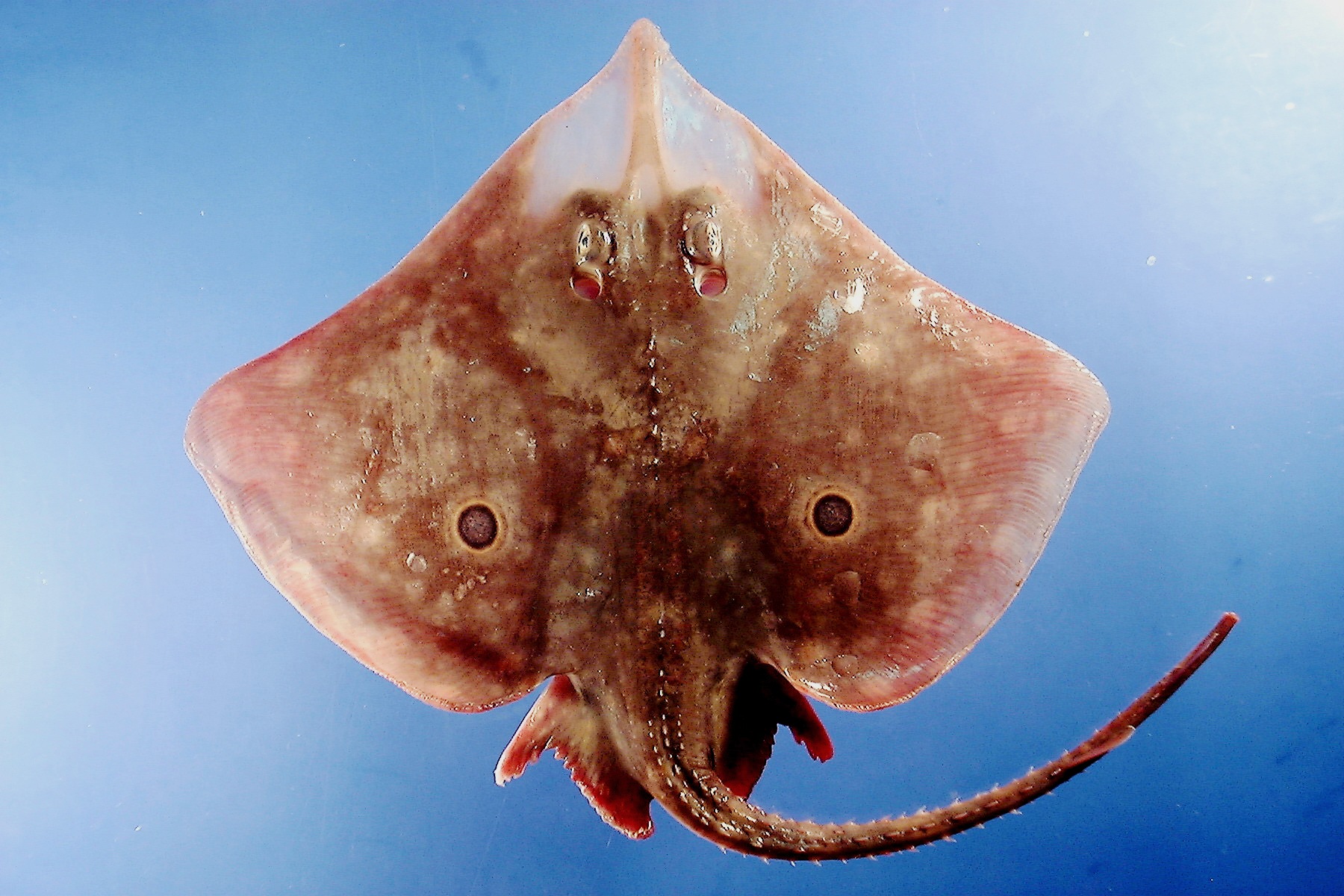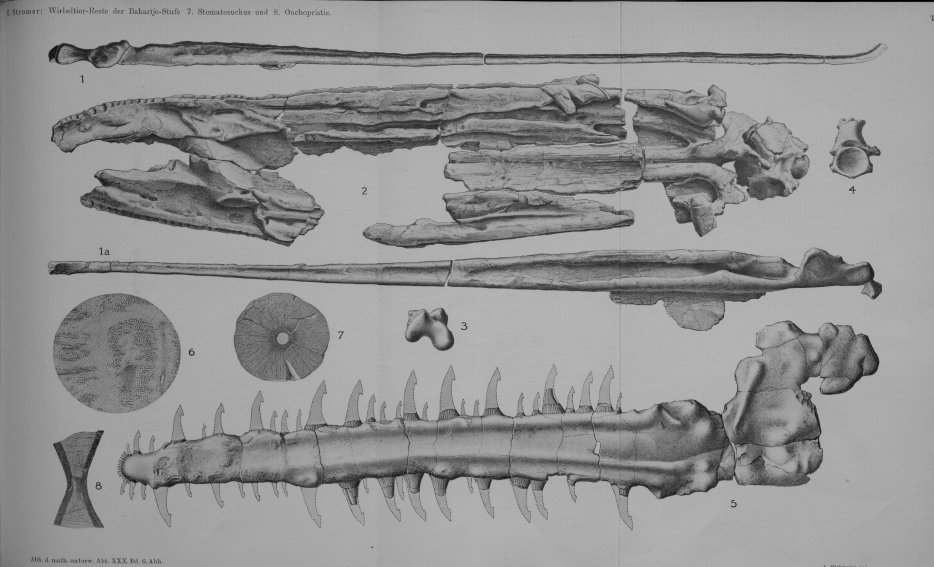|
Rajiformes
Rajiformes is one of the four Order (biology), orders in the clade Batomorphi, often referred to as the superorder Batoidea, flattened cartilaginous fishes related to sharks. Rajiforms are distinguished by the presence of greatly enlarged pectoral fins, which reach as far forward as the sides of the head, with a generally flattened body. The undulatory pectoral fin motion diagnostic to this taxon is known as Batoid locomotion, rajiform locomotion. The eyes and Spiracle (vertebrates), spiracles are located on the upper surface of the head and the gill slits are on the underside of the body. Most species give birth to live young, although some lay eggs enclosed in a horny capsule ("mermaid's purse"). Characteristics Rajoids typically have a dorsoventrally flattened body. The snout is slender and pointed and the wide mouth, often covered with a fleshy nasal flap, is on the underside of the head. The eyes and well-developed spiracles are located on the top of the head. In most spec ... [...More Info...] [...Related Items...] OR: [Wikipedia] [Google] [Baidu] |
Batomorphi
Batomorphi is a division of cartilaginous fishes, commonly known as rays, this taxon is also known as the superorder Batoidea, but the 5th edition of ''Fishes of the World'' classifies it as the division Batomorphi. They and their close relatives, the sharks, compose the subclass Elasmobranchii. Rays are the largest group of cartilaginous fishes, with well over 600 species in 26 families. Rays are distinguished by their flattened bodies, enlarged pectoral fins that are fused to the head, and gill slits that are placed on their ventral surfaces. Anatomy Batomorphs are flat-bodied, and, like sharks, are cartilaginous fish, meaning they have a boneless skeleton made of a tough, elastic cartilage. Most batomorphs have five ventral slot-like body openings called gill slits that lead from the gills, but the Hexatrygonidae have six. Batomorph gill slits lie under the pectoral fins on the underside, whereas a shark's are on the sides of the head. Most batomorphs have a flat, mantle-l ... [...More Info...] [...Related Items...] OR: [Wikipedia] [Google] [Baidu] |
Sawfishes
Sawfish, also known as carpenter sharks, are a Family (biology), family of very large batoidea, rays characterized by a long, narrow, flattened rostrum (anatomy), rostrum, or nose extension, lined with sharp transverse plane, transverse teeth, arranged in a way that resembles a saw. They are among the List of largest fish, largest fish, with some species reaching lengths of about . They are found worldwide in tropical and subtropical regions in coastal Seawater, marine and brackish estuarine waters, as well as freshwater rivers and lakes. All species are critically endangered. They should not be confused with sawsharks (order Pristiophoriformes) or the extinct Sclerorhynchoidei, sclerorhynchoids (order Rajiformes) which have a similar appearance, or swordfish (family Xiphiidae) which have a similar name but a very different appearance. Sawfishes are relatively slow breeders and the females give birth to live young. They feed on fish and invertebrates that are detected and capt ... [...More Info...] [...Related Items...] OR: [Wikipedia] [Google] [Baidu] |
Batoid Locomotion
Batomorphi is a Division (taxonomy), division of Chondrichthyes, cartilaginous fish consisting of Skate (fish), skates, Batoidea, rays and other fish all characterized by Anatomical terms of location, dorsoventrally flattened bodies and large Fish fin, pectoral fins fused to the head. This distinctive Morphology (biology), morphology has resulted in several unique forms of locomotion. Most batomorphs exhibit median paired fin swimming, utilizing their enlarged pectoral fins. Batomorphs that exhibit median paired fin swimming fall somewhere along a spectrum of swimming modes from mobuliform to rajiform based on the number of waves present on their fin at once. Of the extant Order (biology), orders of Batomorphi this holds truest for the Myliobatiformes (rays) and the Rajiformes (skates). The two other orders: Rhinopristiformes and Electric ray, Torpediniformes exhibit a greater degree of body caudal fin swimming. Mobuliform swimming Mobuliform swimming is common in pelagic Mylio ... [...More Info...] [...Related Items...] OR: [Wikipedia] [Google] [Baidu] |
Sclerorhynchoidei
Sclerorhynchoidei is an extinct suborder of Rajiformes, rajiform Batoidea, rays that had long Rostrum (anatomy)#Vertebrates, rostra with large Fish scale#Placoid scales, denticles similar to Sawfish, sawfishes and Sawshark, sawsharks. This feature was convergent evolution, convergently evolved, recently proposed as 'pristification', and their closest living relatives are actually Skate (fish), skates. While they are often called "sawfishes", sawskates is a more accurate common name proposed in 2021 for sclerorhynchoids, which has been subsequently used by other researchers. The suborder contains five named families: Ganopristidae, Ischyrhiza, Ischyrhizidae, Onchopristis, Onchopristidae, Ptychotrygonidae, and Schizorhizidae. Several genera (see below) are not currently placed in any of these families. Sclerorhynchoids first appeared in the Barremian and went extinct during the Cretaceous–Paleogene extinction event, with former Paleocene occurrences being misidentifications or Fo ... [...More Info...] [...Related Items...] OR: [Wikipedia] [Google] [Baidu] |
Arhynchobatidae
Arhynchobatidae is a family of skates whose members are commonly known as the softnose skates. It belongs to the order Rajiformes in the superorder Batoidea of Ray (fish), rays. At least 104 species have been described, in 13 genera. Softnose skates have at times been placed in the same family as Rajidae, hardnose skates, but most recent authors recognize them as a distinct family. Members of the Arhynchobatidae can be distinguished from hardnose skates in having a soft and flexible snout, as well as a more or less reduced rostrum. Genera Arhynchobatidae contains the following genera: Conservation In 2010, Greenpeace International added the spotback skate to its seafood red list. "The Greenpeace International seafood red list is a list of fish that are commonly sold in supermarkets around the world, and which have a very high risk of being sourced from unsustainable fisheries." References External links Rajiformes, . Ray families Fish described in 1934 Taxa named by ... [...More Info...] [...Related Items...] OR: [Wikipedia] [Google] [Baidu] |
Anacanthobatidae
The Anacanthobatidae, the smooth skates or leg skates, are a family of skates found at depths below in the Indian, Pacific and Atlantic Oceans. They lack the dorsal denticles (sharp, tooth-like scales) of other rays, hence their name, from Greek ''an-'' meaning "without", ''acantha'' meaning "thorn", and ''bathys'' meaning "deep". They are bottom-dwelling fishes found on the continental slopes of tropical and subtropical The subtropical zones or subtropics are geographical zone, geographical and Köppen climate classification, climate zones immediately to the Northern Hemisphere, north and Southern Hemisphere, south of the tropics. Geographically part of the Ge ... waters. Genera Anacanthobatidae contains the following genera: References Anacanthobatidae {{Rajiformes-stub ... [...More Info...] [...Related Items...] OR: [Wikipedia] [Google] [Baidu] |
Onchopristidae
''Onchopristis'' is an extinct genus of sclerorhynchoid, or sawskate, from the Cretaceous of North Africa, Europe, North America, and potentially South America. It contains two valid species, ''O. numida'' and ''O. dunklei'', though some researchers argue that both may be considered a single taxon with variation in morphology caused by a wide geographical range. Specimens of ''Onchopristis'' have been discovered in coastal and fluvial deposits dated from the Barremian to the Cenomanian ages (~125-94 mya), making this genus one of the oldest known sclerorhynchoids. Discovery and naming In 1905, the French paleontologist Émile Haug named '' Gigantichthys numidus'' based fragmentary rostral denticles from the Continental intercalaire of Algeria, and named ''Platyspondylus foureaui'' based on vertebrae from the same formation. Articulated specimens have confirmed that the rostral denticles and vertebrae belong to the same species. In 1917, Ernst Stromer assigned "''G''". ''numidus ... [...More Info...] [...Related Items...] OR: [Wikipedia] [Google] [Baidu] |
Anacanthobatis
The spotted legskate (''Anacanthobatis marmorata'') is a species of cartilaginous fish, a ray belonging to the family Anacanthobatidae, the smooth skates. It is the only species in the monospecific genus ''Anacanthobatis''. It is found off Mozambique and South Africa. This is a demersal fish occurring on soft substrates on the continental shelf break and upper continental slope A continental margin is the outer edge of continental crust abutting oceanic crust under coastal waters. It is one of the three major zones of the ocean floor, the other two being deep-ocean basins and mid-ocean ridges. The continental margi ... at depths of . Classification The spotted legskate is the only species in its genus, previously several species have been assigned to this genus, but most are now placed in '' Sinobatis'', '' Springeria'', and '' Schroederobatis'', leaving only ''A. marmoratus'' in ''Anacanthobatis''. References External links Species Description of Anacanthobatis marmo ... [...More Info...] [...Related Items...] OR: [Wikipedia] [Google] [Baidu] |
Gurgesiellidae
Pygmy skates are cartilaginous fish belonging to the family Gurgesiellidae in the superorder Batoidea of rays. Nineteen species in three genera are known.Weigmann, S., Séret, B., Last, P.R. & McEachran, J.D. 2016. Pygmy Skates, Family Gurgesiellidae. Pp. 473–493 in Last, P.R., White, W.T., Carvalho, M.R., Séret, B., Stehmann, M. & Naylor, G.J.P. (eds.). Rays of the World. CSIRO Publishing: Melbourne. . Genera * '' Cruriraja'' Bigelow & Schroeder __NOTOC__ Schroeder is a North German (from Schröder) occupational name for a cloth cutter or tailor, from an agent derivative of Middle Low German , "to cut". The same term was occasionally used to denote a gristmiller as well as a shoemaker, wh ..., 1948 * '' Fenestraja'' McEachran & Compagno, 1982 * '' Gurgesiella'' de Buen, 1959 References Ray families Rajiformes {{Rajiformes-stub ... [...More Info...] [...Related Items...] OR: [Wikipedia] [Google] [Baidu] |
Ischyrhiza
''Ischyrhiza'' is an extinct genus of sclerorhynchoid ray from the Late Cretaceous (Cenomanian-Maastrichtian). It had a large, toothed rostrum closely resembling that of a modern-day sawfish. Despite formerly being classified within a family of extinct sawfish-like rays known as Sclerorhynchidae, phylogenetic analyses indicate that ''Ischyrhiza, Schizorhiza'', and ''Onchopristis'' form a distinct clade that groups closer with the extant family Rajidae, which contains the true skates, possibly rendering the suborder Sclerorhynchoidei paraphyletic. Fossils of the genus have been found in Canada, the United States, the Aguja Formation of Mexico, the Bissekty Formation of Uzbekistan, the Tamayama Formation of Japan, the Dukamaje Formation The Dukamaje Formation is a geological formation in Niger and Nigeria whose strata date back to the Late Cretaceous The Late Cretaceous (100.5–66 Ma) is the more recent of two epochs into which the Cretaceous Period is divided i ... [...More Info...] [...Related Items...] OR: [Wikipedia] [Google] [Baidu] |
Mermaid's Purse
An egg case or egg capsule, often colloquially called a mermaid's purse, is the casing that surrounds the eggs of oviparous chondrichthyans. Living chondricthyans that produce egg cases include some sharks, skates and chimaeras. Egg cases typically contain one embryo, except for big skate and mottled skate egg cases, which contain up to 7 embryos. Oviparity is completely absent in the superorder Squalomorphi. Egg cases are also thought to have been produced by some extinct chondrichthyan groups, such as hybodonts and xenacanths. Description Egg cases are made of collagen protein strands, and are often described as feeling rough and leathery. Some egg cases have a fibrous material covering the outside of the egg case, thought to aid in attachment to substrate. Egg cases without a fibrous outer layer can be striated, bumpy, or smooth and glossy. With the exception of bullhead shark eggs, egg cases are typically rectangular in shape with projections, called horns, at ea ... [...More Info...] [...Related Items...] OR: [Wikipedia] [Google] [Baidu] |
Schizorhizidae
Schizorhizidae is an extinct family of cartilaginous fish from the Late Cretaceous belonging to the suborder Sclerorhynchoidei. This family contains the genera '' Harranahynchus'' and ''Schizorhiza''. It was originally named as a subfamily of Sclerorhynchidae, but was later raised to the rank of family. References Sclerorhynchoidei † A dagger, obelisk, or obelus is a typographical mark that usually indicates a footnote if an asterisk has already been used. The symbol is also used to indicate death (of people) or extinction (of species or languages). It is one of the mo ... Prehistoric cartilaginous fish families {{paleo-rajiformes-stub ... [...More Info...] [...Related Items...] OR: [Wikipedia] [Google] [Baidu] |



